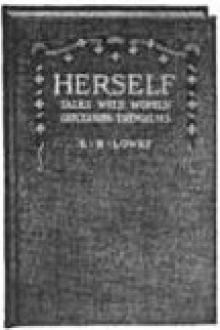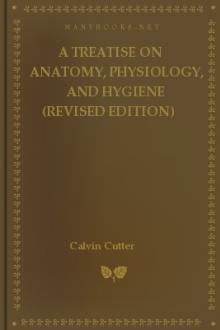Genre Literary Collections. Page - 10

of the body, the development of the pelvis so that the hips become more prominent, and a change in the mental qualities of the child, the girl naturally becoming more retiring. The menstrual function usually is not established at once, there being premonitory symptoms of a vague nature. There may be, at first, only a slight discharge of mucus tinged with blood, later the normal menstrual flow will be established.
During this period of puberty there are great changes taking place in the girl's internal organs. This change and development requires considerable of the girl's strength and naturally influences her nervous system. It is for this reason that a girl at this period of her life should not be subjected to any great exertion, either physical or mental. She should have plenty of light, healthful exercise in the open air, but should not indulge in any very violent exercise. A little care at this time often will save her years of suffering. As the nervous system is greatly affected at this period the

to literary works is vital for enabling the sharing of knowledge, art, music and culture.
Regulatory Environment
Project Gutenberg must adhere to U.S. laws involving operation as a not-for-profit corporation. However, these regulations are not sector specific. Project Gutenberg must be exceedingly careful to respect U.S. copyright laws regarding the works that they digitise and make available over the Internet. However, once a publication has been verified as being in the public domain, there are no other legal restrictions affecting Project Gutenberg.
Preservation Activity
Policies and Strategies
Project Gutenberg scans literary works and employs OCR technology to create eBooks. In some cases, eBooks are typed in by hand. The eBooks are then edited by a team of volunteer proof-readers. There are procedures and guidelines available online for volunteers to consult when scanning and editing texts for Project Gutenberg to ensure that all eBooks follow a standard format. O

es_ added on
Will make the toe so comfortable,
We should like to sing a song.
[Illustration]
The heel we reach in perfect order,
And leave the measure neat;
Some shoes are made which look much broader
When put upon the feet.
[Illustration]
The _instep_ now we see again,
And measure as before,
One-half inch off will answer us,
No less, and not much more.
For if we do we are apt to find
The place where shoes do pinch;
Across the _ball_ we're now inclined,
Still measuring by the inch.
[Illustration]
This is at times a tender spot:
Bunions develop there;
And when they do 'tis not forgot,
We may be e'er so fair.
One-quarter _size_ we leave off here,
As on our way we go,
Travelling on, without a fear,
Until we reach the toe.
[Illustration]
Another quarter we would say,
At this point we may drop,
For we are now quite far away
From the ankle and the top.
But further ye

s plants of the genus Colchicum, such as the autumncrocus. The dried ripe seeds or corms (short thick solid food-storingunderground stem) of the autumn crocus which yield colchicine.
collodionHighly flammable, colorless or yellowish syrupy solution of pyroxylin,ether, and alcohol, used as an adhesive to close small wounds and holdsurgical dressings, in topical medications, and for making photographicplates.
colocynth (bitter apple)Old World vine (Citrullus colocynthis) bearing yellowish, green-mottledfruits the size of small lemons. The pulp of the fruit is a stronglaxative.
colombo (calumba)Root of an African plant (Jatrorrhiza palmata, family Menispermaceae)containing columbin; it is used as a tonic called calumba root orcolombo root.
colostrum (foremilk)Thin yellowish fluid secreted by the mammary glands at birth, rich inantibodies and minerals. It precedes the production of true milk.
coltsfoot (galax)Eurasian herb (Tussilago farfara), natural

of the children a conviction of the truth of what they say; while, on theother hand, those who, in theory at least, occupy the position thatthe direct falsifying of one's word is never justifiable, act at adisadvantage in attempting this method. For although, in practice, they areoften inclined to make an exception to their principles in regard to truthin the case of what is said to young children, they can not, after all,tell children what they know to be not true with that bold and confidentair necessary to carry full conviction to the children's minds. They areembarrassed by a kind of half guilty feeling, which, partially at least,betrays them, and the children do not really and fully believe what theysay. They can not suppose that their mother would really tell them whatshe knew was false, and yet they can not help perceiving that she does notspeak and look as if what she was saying was actually true.
Monsieur and Madame Croquemitaine.
In all countries there are many,

out from 3 to 8 grams of sugar a day. By the old method we could not do away with the last traces of sugar.
The Allen treatment was started with two starvation days. On the second he was sugar-free--but showed 2.6 grams of sugar the following day on 12 grams of carbohydrate and 40 grams of protein. (This was one of the earlier cases when the diet was raised too quickly after starvation.) After one more starvation day and two vegetable days he stayed sugar-free while the diet was raised slowly to 30 grams of carbohydrate and 45 grams of protein, calories about 2000. Discharged sugar-free on this diet.
Weight at entrance, 109 pounds. Weight at discharge, 110 pounds.
* * * * *
Case 3. A man of 35, a severe diabetic, entered Dec. 28, 1914. He had been in the hospital the previous July for a month and could never be made sugar-free with the old method of treatment. At entrance he was putting out 2.5% of sugar (135 grams) per day with strongly positive acetone and diacetic acid tests. Tw

s which are performed by Conjurations, are neither Natural nor Supernatural, but Diabolical, belonging unto Sorcery, and are prohibited all good Christians; so likewise all those Means which oppose Holy Writ, Gods Word and Commandments, are to be rejected and refuted by true Natural Cabalists; I say this, because a certain distinction and sure order ought to be found of the Natural, Supernatural, Unnatural things.
In like manner there appertains unto Supernatural things, all the Water-Spirits, as the Syrens, Succubi, & other Water-Nymphs, with their Relations, as likewise the Terrestrial Spirits, and those which inhabit the Air, who sometimes are heard, seen, or perceived, sometimes foretelling Death or other Disasters, sometimes they discover by their Apparition Riches and good Fortune in certain places, and the Fiery Spirits appertain here also, which appear in a fiery shape, or like a burning Light; all these are Spirits having untangible Bodies, yet are they not such Spirits a

iary Aiming Points--Firing at Moving Targets-- Night Firing--Fire Direction and Control--Distribution of Fire--Individual Instruction in Fire Distribution-- Designation of Targets--Exercises in Ranging, Target Designation Communication, etc.
PART V
CARE OF HEALTH AND KINDRED SUBJECTS
* CHAPTER I. =CARE OF THE HEALTH=--Importance of Good 1451-1469 Health--Germs--The Five Ways of Catching Disease-- Diseases Caught by Breathing in Germs--Diseases Caught by Swallowing Germs--Disease Caught by Touching Germs-- Diseases Caught from Biting Insects.
* CHAPTER II. =PERSONAL HYGIENE=--Keep the Skin Clean-- 1470-1477 Keep the Body Properly Protected against the Weather-- Keep the Body Properly Fed--Keep the Body Supplied with Fresh Air--Keep the Body well Exercised--Keep the Body Rested by Sufficient Sleep--Keep the Body Free of Wastes.
* CHAPTER III. =FIRST AID TO THE SICK AND INJURED= 1478-1522 --Objectof Teaching First Aid--Asphyxiation by Gas-- Bite of Dog--Bite of Snake--Bleeding-

ena under varied circumstances, and endeavour to deduce the laws of their relations. Every natural phenomenon is, to our minds, the result of an infinitely complex system of conditions. What we set ourselves to do is to unravel these conditions, and by viewing the phenomenon in a way which is in itself partial and imperfect, to piece out its features one by one, beginning with that which strikes us first, and thus gradually learning how to look at the whole phenomenon so as to obtain a continually greater degree of clearness and distinctness. In this process, the feature which presents itself most forcibly to the untrained inquirer may not be that which is considered most fundamental by the experienced man of science; for the success of any physical investigation depends on the judicious selection of what is to be observed as of primary importance, combined with a voluntary abstraction of the mind from those features which, however attractive they appear, we are not yet sufficiently advanced in science to inv

ionally in all directions, while plants grow upwards and downwards from a collet only. The food of animals is organic, while that of plants is inorganic; the latter feeding entirely upon the elements of the soil and atmosphere, while the former subsist upon the products of the animal and vegetable kingdoms. The size of the vegetable is in most cases limited only by the duration of existence, as a tree continues to put forth new branches during each period of its life, while the animal, at a certain time of life, attains the average size of its species.
13. One of the most important distinctions between animals and plants, is the different effects of respiration. Animals consume the oxygen of the atmosphere, and give off carbonic acid; while plants take up the carbonic acid, and restore to animals the oxygen, thus affording an admirable example of the principle of compensation in nature.
14. But the decisive distinctions between animals and plants are